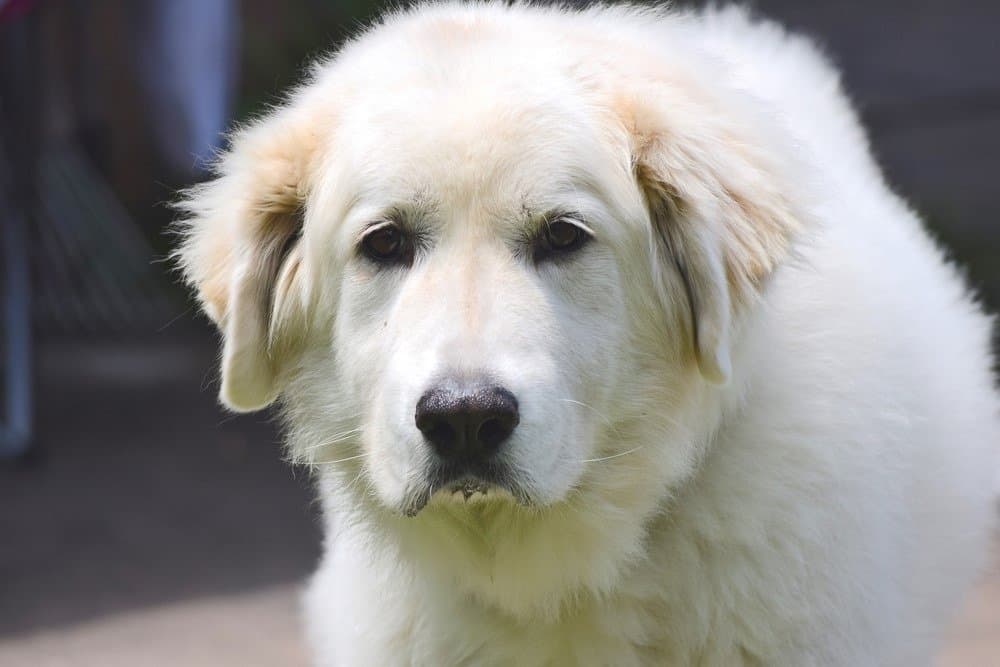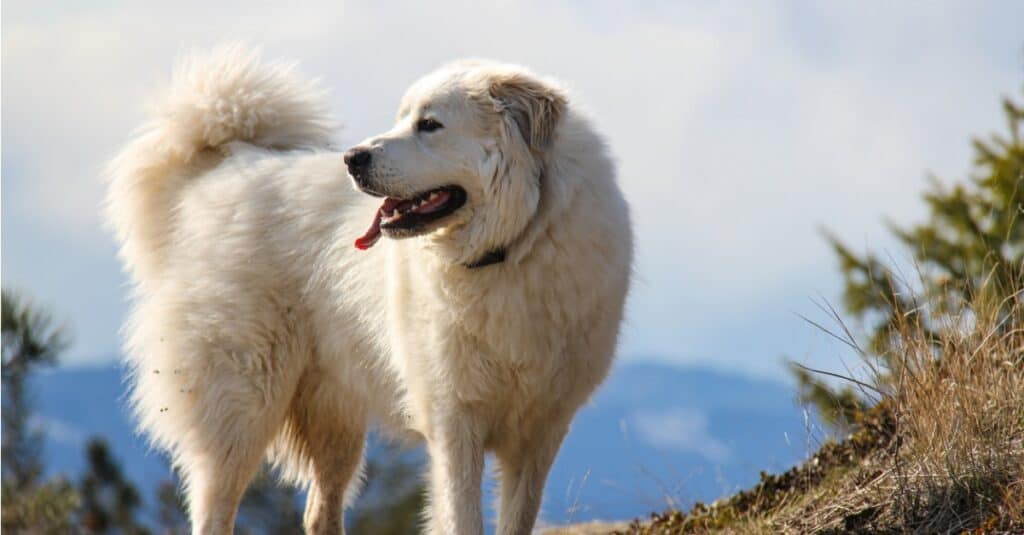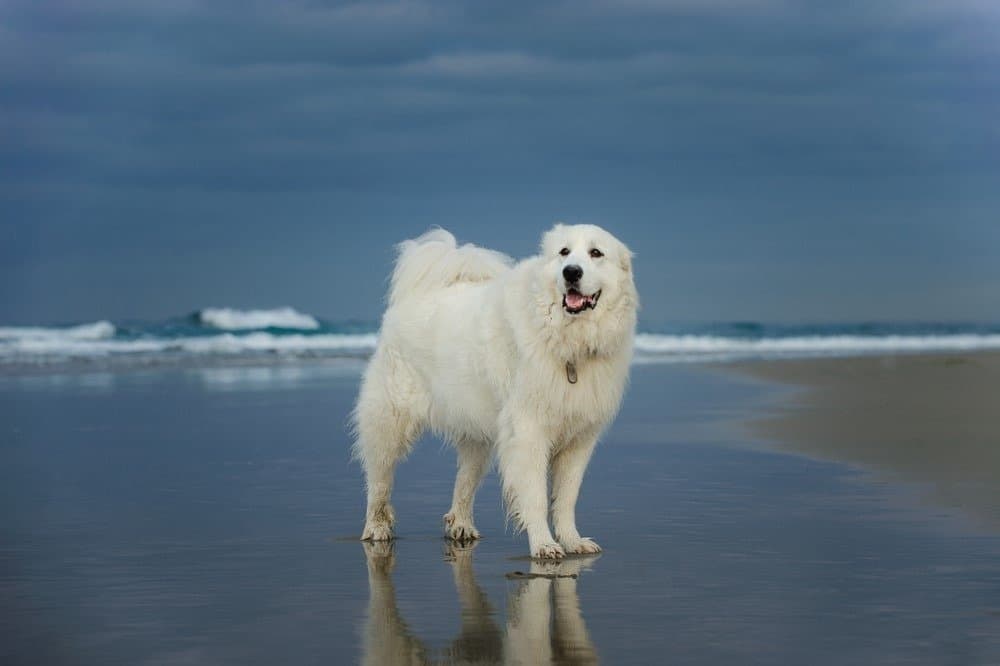Great Pyrenees are one of the highest-shedding dog breeds in the world! Their thick, medium-length coat sheds year-round, with increased shed in the spring as they lose their winter coat and the undercoat restructures itself for the summer months.
We’ll talk more about the Great Pyrenees coat, how much it sheds, and how to keep their fur healthy and off of your carpets below!
Great Pyrenees Coat Characteristics
| Coat Length | Medium |
| Shedding Frequency | Moderate |
| Grooming Needs | Brush coat thoroughly once a week |
| Fur or Hair? | Fur |
| Hypoallergenic? | No |

Great Pyrenees
dogs shed year-round, but their heaviest shedding season is in the spring.
©Ggeek/Shutterstock.com
Do Great Pyrenees Ever Stop Shedding?
Great Pyrenees dogs shed year-round, but their heaviest shedding season is in the spring. If you’re dealing with this big winter coat loss, the good news is that the shedding will lessen once your pup sheds all of their undercoat.
If you’re wondering when your Great Pyrenees will stop shedding altogether, though, unfortunately, the answer is never!
How do you Make a Great Pyrenees Shed Less?
Although Great Pyrenees dogs will always shed heavily, there are ways to reduce the shed fur you find around the house. They include:
- Brushing them weekly with a pin or slicker brush. Infrequent brushing or using the wrong tools means you aren’t getting the shed fur out from their coat, which can lead to it falling on your carpet, sofa, and clothes!
- Bathing them with a de-shedding shampoo. This shampoo is made to remove loose fur and promote a healthy coat.
- Feeding a high-quality diet. Nutritional deficiencies can lead to unhealthy skin and coats for your pup, which can increase the amount they shed.
Here are some additional tips for keeping your home clean with a high-shedding Great Pyrenees:
- A good vacuum is your best friend! I like having a vacuum with a pet attachment and crevice tool. These help pick up fur from hard-to-reach areas. I also prefer vacuums that can transition from upright to a light handheld device, making it easier to vacuum the stairs and furniture!
- Carpet rakes pull out fur that vacuums can’t. Long fur can often tangle in your carpet fibers, so it doesn’t get sucked up by the vacuum. A carpet rake will loosen the fur so you can either grab it with your hands or vacuum it away.
- When possible, brush your Great Pyrenees outdoors. Just be sure to pick up the fur if your dog is on a topical parasite preventative, as this can make the fur toxic to local wildlife such as birds.
- Use furniture and car seat covers. Loose fur from the cover can be shaken into the trash, then you can toss the covers themselves into the washing machine in a mesh bag.
This is easier than vacuuming the couch or your car’s back seats every day, and stops you, your family, and your guests from sitting in fur.

PyreneesThe Great Pyreenes is known for its distinctive white coat and large size.
©iStock.com/creativex
How to Groom a Great Pyrenees
A good grooming routine for your Great Pyrenees involves more than just their coat! It also involves the maintenance of their teeth, ears, and nails.
The best grooming routines also include looking over your dog’s body for any changes or abnormalities, which helps you to learn what’s normal for them and catch illnesses early.
Below, we’ll discuss:
- Brushing your Great Pyrenees once a week
- Bathing your dog once every couple of months
- Trimming their nails once monthly
- Cleaning your pup’s ears monthly
- Brushing their teeth every day

The best grooming routines also include looking over your dog’s body for any changes or abnormalities, which helps you to learn what’s normal for them and catch illnesses early.
©everydoghasastory/Shutterstock.com
Brushing Your Great Pyrenees
Luckily, Great Pyrenees dogs don’t need to be brushed too often. However, you should set aside at least a half hour one day of the week.
During their weekly brushing, Great Pyrenees dogs need to be brushed thoroughly from top to bottom. You could also break this down into smaller, daily sessions if desired.
Reasons to do this are if you lack time to go through the whole coat at once, or if your pup dislikes grooming and can’t handle long sessions.
The American Kennel Club recommends using either a slicker brush or a pin brush to groom your dog. Pay special attention to the areas around your dog’s armpits, hips, and rear end.
While brushing their coat, be sure to check for any skin or fur abnormalities such as redness, dandruff, pests, or greasy coat.
Bathing Your Great Pyrenees
These dogs are relatively clean, and don’t ned baths too regularly. However, you should bathe them once every two months to keep their thick coats clean.
Use a dog shampoo, as it’s formulated to be gentler on the skin and coat than human soaps. Work it thoroughly into your dog’s coat down to the skin.
Then, rinse it away just as thoroughly, making sure not to leave soap bubbles trapped in the undercoat or on the skin. This is easy to do with such a thick coat and can cause skin irritation.
Trimming Your Great Pyrenees’ Nails
Trimming your Great Pyrenees’ nails at least once monthly stops them from causing your dog pain. If nails grow too long, they make it painful for a dog to walk. They can also snag on objects, break unevenly, or grow painfully into the pads of the feet.
The most important aspect of trimming the nails is to avoid the quick. This is a spot near the base of the nail which is filled with blood.
On light-colored nails, you can see the quick easily as it’s pink in color. Trim just the tip of the nail to avoid bleeding or pain.
Here are some extra tips for trimming your Great Pyrenees’ nails:
- Desensitize them to handling first if possible. Touch your pup’s feet when they’re relaxed and reward them with treats to get them used to the experience.
- Introduce the nail trimmers slowly.
- Use cornstarch or flour to stop bleeding if you cut into the quick. See a veterinarian if the bleeding doesn’t stop within a few minutes.
Cleaning Your Great Pyrenees’ Ears
Most Great Pyrenees should have their ears cleaned once a month. If your pup has allergies or has had ear infections in the past, your veterinarian might recommend you cleaning them more frequently as a preventative.
Here’s how to clean a Great Pyrenees dog’s ears:
- Use dog ear cleaning solution or baby oil to dampen a paper towel or cotton pad.
- Flip your dog’s ear to the top of their head for easy access to the underside.
- Gently clean the outer ear, but not the ear canal.
- Never stick anything into your dog’s ear canal, as you can push the wax in further and hurt them.
If there is wax build-up in the inside of your pup’s ear, call your veterinarian. They can clean it without hurting your dog or damaging their ears.
Your vet can also tell you if the wax build-up is indicative of another problem, such as an ear infection.
While cleaning your dog’s ears, also look for signs of ear problems such as redness, swelling, abnormal discharge, or odor. Discuss any symptoms you see with your vet.
Brushing Your Great Pyrenees’ Teeth
Lastly, your Great Pyrenees’ teeth should be brushed daily. This removes plaque and decreases their risk of dental disease.
To brush your dog’s teeth, use a toothbrush and dog toothpaste. Human toothpaste is toxic to dogs, so avoid using it.
Introduce your pup to having their mouth handled as early as possible, and introduce the toothbrush slowly.
Don’t expect to brush all of the teeth at once. Like any training, keep things short and positive. Over time, you’ll be able to do more and more.
If you can’t brush your dog’s teeth safely, such as if they bite when their mouth is handled, look into alternatives like treats and chew toys that clean the teeth. These aren’t as effective, but better than nothing!
Also, talk to your veterinarian about how often your Great Pyrenees should have their teeth professionally cleaned. Most recommend a dental at least once a year.
Up Next:
The photo featured at the top of this post is © iStock.com/JZHunt
Ready to discover the top 10 cutest dog breeds in the entire world?
How about the fastest dogs, the largest dogs and those that are -- quite frankly -- just the kindest dogs on the planet? Each day, AZ Animals sends out lists just like this to our thousands of email subscribers. And the best part? It's FREE. Join today by entering your email below.
Sources
- AKC, Available here: https://www.akc.org/dog-breeds/great-pyrenees/
- VCA Hospitals, Available here: https://vcahospitals.com/know-your-pet/ear-infections-in-dogs-otitis-externa
- AKC, Available here: htps://www.akc.org/expert-advice/health/ear-mites-in-dogs/
- VCA Hospitals, Available here: https://vcahospitals.com/know-your-pet/dental-disease-in-dogs
FAQs (Frequently Asked Questions)
Why is the Great Pyrenees one of the highest-shedding dog breeds in the world?
Great Pyrenees are one of the highest-shedding dog breeds in the world! Their thick, medium-length coat sheds year-round, with increased shed in the spring as they lose their winter coat and the undercoat restructures itself for the summer months.
How do you make a Great Pyrenees shed less?
Brushing them weekly with a pin or slicker brush. Infrequent brushing or using the wrong tools means you aren’t getting the shed fur out from their coat, which can lead to it falling on your carpet, sofa, and clothes!
Bathing them with a deshedding shampoo. This shampoo is made to remove loose fur and promote a healthy coat.
Feeding a high-quality diet. Nutritional deficiencies can lead to unhealthy skin and coat for your pup, which can increase the amount they shed.
Thank you for reading! Have some feedback for us? Contact the AZ Animals editorial team.






